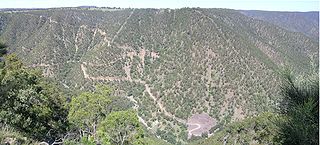| New England Peppermint Grassy Woodland | |
|---|---|
 New England Highway traversing the grasslands New England Highway traversing the grasslands | |
| Ecology | |
| Realm | Australasia |
| Biome | Tropical and subtropical grasslands, savannas, and shrublands |
| Borders | |
| Geography | |
| Country | Australia |
| Elevation | 750–900 metres (2,460–2,950 ft) |
| Coordinates | 30°12′S 151°31′E / 30.2°S 151.52°E / -30.2; 151.52 |
| Geology | Sedimentary rock |
| Climate type | Subtropical highland climate (Cfb) |
| Soil types | Loam-clay |
The New England Peppermint Grassy Woodland is a grassy-woodland community primarily situated in the New England and Northern Tablelands regions in northern New South Wales, Australia. Named after the Eucalyptus nova-anglica, it is listed as a critically endangered ecological communities (TECs) under the Environment Protection and Biodiversity Conservation Act 1999.
Geography

The community is found throughout the Northern Tablelands and New England bioregion in northern New South Wales, near the Queensland border, at an elevation above 750 m, on cold drainage lines, upper riparian areas, valley bottoms, and low-lying flats with badly drained soils of moderate to high fertility, with some pockets in the NSW North Coast and Nandewar.
The community stretches from Wallangarra in the north, Armidale in the centre, to Nundle in the south, though only 10% of its original habitat remains. It covers the Guyra, Inverell and Tenterfield Local Government Areas. It is one of the most significantly impacted ecoregion on the Northern Tablelands due to its fertile grazing land.
Ecology
Ranging from 35 to 50 trees per hectare, the trees are mainly composed of E. nova-anglica, though secondary species such as, Eucalyptus stellulata, Eucalyptus stellulata, Eucalyptus dalrympleana, Eucalyptus blakelyi, Eucalyptus conica, Eucalyptus pauciflora and Angophora floribunda.
There is very small and undefined amount of shrubs, but a variety of grass and herbs species in the understory are present, with the common ones being Poa sieberiana and Themeda triandra. The scarce shrubs would include Bursaria spinosa, Rubus parvifolius, Lissanthe strigosa, Leucopogon fraseri, Melichrus urceolatus and Acacia dealbata.
See also
References
- New England Peppermint (Eucalyptus nova-anglica) Grassy Woodlands Department of the Environment (2022). New England Peppermint (Eucalyptus nova-anglica) Grassy Woodlands in Community and Species Profile and Threats Database, Department of the Environment, Canberra. Retrieved 8 September 2022.
- New England Peppermint (Eucalyptus nova-anglica) Grassy Woodlands Environmental Justice Australia for Environment Council of Central Queensland. Retrieved 8 September 2022.
- New England Peppermint (Eucalyptus nova-anglica) Grassy Woodland Trees on the Tablelands. NSW Government. Retrieved 8 September 2022.
- New England Peppermint (Eucalyptus nova-anglica) Woodland on Basalts and Sediments in the New England Tableland Bioregion - profile Office of Environment & Heritage. Retrieved 8 September 2022.
- FARMING AND NATIONALLY PROTECTED NEW ENGLAND PEPPERMINT GRASSY WOODLANDS The Department of Sustainability, Environment, Water, Population and Communities. Retrieved 8 September 2022.